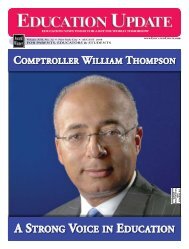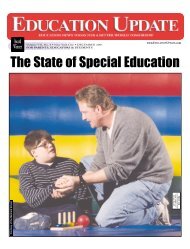Education Update - July 2002
Education Update - July 2002
Education Update - July 2002
Create successful ePaper yourself
Turn your PDF publications into a flip-book with our unique Google optimized e-Paper software.
JULY <strong>2002</strong> ■ EDUCATION UPDATE ■ SPECIAL EDUCATION19INCLUSION PROGRAM ATFRANCIS LEWIS HSBy DAVE CODDINGTONOur Inclusion Program at Francis LewisHigh School in Queens has been an everchangingwork in progress. We began the programin September of 1997 without any priorplan. One day before school started, I wasassigned as the Methods and Resource Teacher,which was the title given to the Special<strong>Education</strong> Teacher in charge of adapting andmodifying the curriculum in an inclusion program.I believe the title is now just plainSpecial <strong>Education</strong> Teacher.Word went out to the Committees on Special<strong>Education</strong> that a new high school inclusion programwas canvassing for students with emotionaldisabilities who might be appropriate toreturn to a mainstream high school setting.These students would be on the same level astheir General Ed. peers as far as testing andother requirements. We started with threeyoung men, two eighteen year olds and one sixteen-year-old.The Principal of Francis LewisHigh School, where we were “guests,” had noprior knowledge of inclusion and was not toothrilled by our start up student populationbecause of their age and prior anti-socialbehaviors. She was, however, diplomaticallysupportive and has become more than a friendto inclusion over the past five years.Just before Thanksgiving in 1997, the twoolder students got into a serious fight in thecafeteria and they were reassigned to anotherprogram. About the same time, our third student,who was an undeclared graffiti artist, wascaught creating a masterpiece in a stairwell.The artist was also removed from the schooland was placed in Home Instruction for lack ofa better placement. I became his tutor in GlobalHistory, Spanish and English after schooleveryday for the remainder of the school year.Over the years, I kept in touch with the artist onHome Instruction. He did well with the one-ononeeducational support that I gave him. Hepassed my classes and was placed in a vocationalprogram, which he dropped out of; butlast I heard, he did finally receive his GED.Success from failure!Our program now includes students with varieddisabilities. We try to start students in ourprogram at age14, the same as their high schoolfreshman peers. First, we set up an interview todetermine if the student and family are acceptingof this style of education. Since we offerboth a full academic program and a truncatedvocational/academic program for students, studentsand parents can choose which programwill best meet their needs.At the beginning of each term (and there aretwo terms a year), I meet with each student’ssubject teachers. We set up goals and anyrubrics that might be needed in each class forgrading my included student’s work. This is amammoth challenge: I meet with 30 or moreteachers each term. Fortunately, it has becomeeasier with repeat teachers. As teachers becomemore accepting of the inclusion process theysometimes seek me out when a student’s workneeds adaptations. That’s a very good sign andit means they are buying into the process andthere is hope for the future. Newly graduatedteachers with some background in inclusiveBy CHRIS ROWAN“In the late summer of that year we lived ina house in a village that looked across the riverand the plains to the mountains.” Name theNobel winning author and the title of the work.Literary Riddleseducation tend to accept my students a lot betterthan the “Chalk and Talk” old timers. Thenew teachers are usually more comfortablewith collaboration and team teaching techniques,and they are more accepting of theParaprofessional’s role in the classroom.It took five years to finally program myinclusion students into General <strong>Education</strong>classes without too many problems. The computersystem did not recognize my students asbeing enrolled in the high school since theywere already enrolled in an off-site Special<strong>Education</strong> school. We were “guests” in theschool without I.D. numbers and without officialclass designations, which resulted in mystudents not being able to go to class. In otherwords, there were serious obstacles to overcomein setting up official class schedules. Adesignated code called “Shared Instruction”was finally created last September and thissolved the dilemma of including our students. Ihad ten students and the high school had threethousand five hundred students. I found outthat I had to wait for my turn to program mystudents and adjust their schedules, just likeany other grade advisor, which added anotherrole to my job. As a grade advisor I had to learnthe requirements for graduation, find out theschedule of standardized testing, learn programmingcodes for classes offered, and a hostof other concepts foreign to a Special Educator.Many times, my biggest obstacles were overcomeby just good public relations. If you can“shmooze” people it will take you a lot lesstime to create a good working program. At thehigh school level collaboration with theGeneral <strong>Education</strong> teachers is done on a “catchme when you can”, basis and “if I have time,we’ll talk about your student.” I make it a pointto “catch” teachers during their preps or lunchhours to discuss student work and progress. Ijoined the high school Executive Board and theSchool Safety Plan Committee with the intentionof presenting myself as less of a “guest”and more of a member of the high school faculty.I learned what the issues were in theschool and attending the meetings gave me theopportunity to advocate for my students.Inclusion is still considered a Special<strong>Education</strong> project or program and not a sharedresponsibility of the educational community asa whole. Economics plays a big factor in thedivision of responsibility but that’s a wholenew ball of wax to investigate. I believe thiswill change as more students with disabilitiesfind their rightful place among the mainstreampopulation. It is easier to include students whenthey are younger and it is easier for the generalpopulation to accept them. I have seen a positivechange in my school over the past fiveyears. Three of my students participate in thehigh school chorus; peer tutorials are up thisyear, socializing with peers in classes hasincreased, and a general feeling of acceptancefrom teachers and students is taking hold.When everyone accepts the fact that we alllearn in different ways and at different speeds,then that will be the day when my job will nolonger be necessary.#Dave Coddington is a teacher at FrancisLewis High School.Answers to this month’s riddle:A Farewell to Arms (1929) by ErnestHemingway. It was set during World War I inItaly and Switzerland.Heiskell Library for the Blind & Physically Handicapped40 WEST 20TH STREET • NEWYORK, NY 10011-4211 • (212) 206-5400;Summer Programs: Saturday concerts startingat 2:00 p.m. on <strong>July</strong> 6 & 13. Summer Reading Club for children and teens: Aug. 24.Picture Book Reading, children ages 5-8: M, T,Th, Fri at 2 pm, <strong>July</strong> 1-Aug. 23.
















